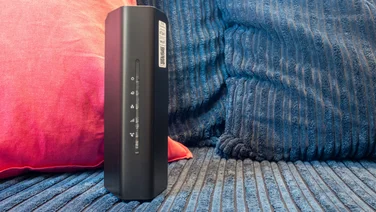To help us provide you with free impartial advice, we may earn a commission if you buy through links on our site. Learn more








- Faster than 802.11ac
- Cheaper than current alternatives
- Not as fast as the competition
- Only dual-band
- No MU-MIMO
If you want to be one of the first to upgrade to the new 802.11ax standard – also known as Wi-Fi 6 – you’ll have to be prepared to pay: we’ve yet to see a next-gen router cost less than £200. The Netgear Nighthawk AX4 gets exceptionally close, however, coming in at a price that undercuts all rivals. The question is: what compromises have been made to achieve that low price?
READ NEXT: These are the best wireless routers you can buy right now
Netgear Nighthawk AX4 router review: What you need to know
The Nighthawk AX4 is a dual-band router that supports the brand-new, high-speed 802.11ax wireless standard, while also maintaining compatibility with 802.11ac, 802.11n and older connection types. It supports 2×2 MIMO on both the 2.4GHz and 5GHz bands and offers four Gigabit Ethernet ports for wired connections. As is usual with standalone routers, there’s no modem built in, so you’ll need to use it in conjunction with a separate cable box or ADSL/fibre modem to connect it to your broadband.
Netgear Nighthawk AX4 router review: Price and competition
At the time of writing, there’s no 802.11ax router that can match the Nighthawk AX4’s £201 price. The closest competitor we’ve seen so far is the Asus RT-AX88U, a highly impressive router that costs £60 more but justifies it with exceptional performance and an extensive feature set. Move up to £280 and you can get Netgear’s own Nighthawk AX8, a swish-looking alternative.








If your budget is tighter, there are plenty of very decent 802.11ac routers that can be had for less than the price of the Nighthawk AX4, such as the £170 TP-Link Archer VR2800 or even the D-Link EXO AC2600, now available online for only £79. Think carefully though before investing in one of these routers, though: this time next year, when Wi-Fi 6 is standard on all new phones and laptops, you might find that your last-generation router is holding you back.
READ NEXT: Asus RT-AX88U review
Netgear Nighthawk AX4 router review: Features and design
Netgear’s Nighthawk routers generally seem to be modelled after stealth bombers and with its black, low-profile design the AX4 is no exception. As you take it out of the box, you might, however, notice that it doesn’t have quite the premium feel of other Nighthawk models. The casing seems flimsy and the twin antennae feel rather loose.
The Wi-Fi toggle and WPS buttons at the front are also unwisely embedded in a high-gloss plastic surround, so when you press either one a big smudgy fingerprint is invariably left behind. Still, once you’re set up, those gripes will soon be forgotten.
At the back of the router, you’ll find four Gigabit LAN ports, of which two support 802.3ad link aggregation, plus an Ethernet WAN connector and a single USB 3 socket – an acceptable minimum of connectivity in our view. Sign up for Netgear’s ReadyCLOUD service and you can access USB-hosted files and folders not only across your local network but over the internet too, via the Netgear website. Access control options are very limited, however, with shares either open to everyone on the network or accessible only to the administrator account.
You can also use USB storage as a backup vault, using either Netgear’s free ReadySHARE Vault software or the File History and Time Machine services built into Windows and macOS. There’s support for DLNA streaming and USB printer sharing, too, but the AX4 doesn’t support mobile internet adapters, so if your connection goes down you’re on your own.








Advanced networking features are accessed from the Nighthawk’s web portal. I don’t love the stark, monochrome look and the way it embeds scrolling frames within scrolling frames is clumsy but it’s simple enough to get around, with the “basic” view exposing commonly used options and more technical settings easily findable under the “advanced” view. It’s quite responsive, too – you’re not left waiting around as you click through different pages.
From here you can activate a guest network on each radio band to keep untrusted clients away from your main network. You can optionally isolate them from each other, too, although you can’t apply an automatic time limit or access schedule to guest connections. It’s also possible to configure support for dynamic DNS services from Netgear, NoIP and DynDNS, and activate the AX4’s built-in OpenVPN server.
While there’s no single parental control module, you can block websites by domain or keyword and get notified by email whenever someone attempts to visit a blocked site. Specific network services and ports can be barred too, either for everyone or for selected IP addresses only. Finally, a traffic meter lets you keep tabs on how much data is flowing through the router – although the data is disappointingly unrevealing as it only shows totals and averages over time, with no way to break the figures down by client or app.
Netgear also offers a router management app for Android and iOS, but this is a simple tool that supports only a handful of basic operations, such as browsing connected clients and enabling the guest network. My favourite function is the live signal strength tester, which makes it easy to check coverage around your home and experiment with different router locations.
If it’s entirely hands-free control you crave, the Nighthawk AX4 also works with Netgear’s Alexa Skill, and with the Google Assistant. As usual, only a few commands are supported, but it could be handy to use voice control to turn the guest network on and off, and to reboot the router – assuming that you’re not doing so because your internet connection has died because then it won’t work anyway.
Netgear Nighthawk AX4 router review: Performance
The Nighthawk AX4 advertises a total wireless throughput of 3Gbits/sec, which breaks down as 600Mbits/sec on the 2.4GHz band and 2.4Gbits/sec on the 5GHz band. That would be a huge claim for an 802.11ac router but, by 802.11ax standards, it’s modest. Both radios in the Asus RT-AX88U are rated for twice the bandwidth.
Still, Wi-Fi is a tricky thing and spec sheets are a very poor guide to real-world performance. To discover what the Nighthawk AX4 is really capable of, I carried out my usual file-copy tests, carting a laptop around my home and measuring upload and download speeds in different rooms. For the 802.11ac tests, I used my Microsoft Surface Laptop with its Marvell Avastar AC 2×2 MIMO adapter, for 802.11ax I used a different laptop with a 2×2 Intel AX200 adapter inside. Here’s how the Netgear Nighthawk AX4 performed over 802.11ac, stacked up against the fastest Wi-Fi 6 router I’ve so far tested:
|
Speeds over 802.11ac (MB/sec) |
Asus AX88U upload |
Netgear AX4 upload |
Asus AX88U download |
Netgear AX4 download |
|
Living room |
17.8 |
20.1 |
32.2 |
39.2 |
|
Rear terrace |
4.2 |
2.2 |
8 |
8.7 |
|
Bedroom |
7.8 |
7.3 |
16.9 |
10.4 |
|
Bathroom |
5 |
3.2 |
10.8 |
8.4 |
The Netgear actually fared slightly better than the Asus at short range, with a particularly impressive download speed of 39.2MB/sec. As I moved away, the AX4’s performance dropped off but download rates remained decent no matter where I roamed: a minimum downstream rate of 8.4MB/sec is equivalent to 67Mbits/sec, meaning I could enjoy more or less the full speed of a standard fibre broadband connection anywhere in my home.








Of course, that’s only half of the story. You wouldn’t buy this router if you only ever wanted to use it in 802.11ac mode and, when I switched to 802.11ax, the AX4 didn’t perform as well.
|
Speeds over 802.11ax (MB/sec) |
Asus AX88U upload |
Netgear AX40 upload |
Asus AX88U download |
Netgear AX40 download |
|
Living room |
39.7 |
40.3 |
70.5 |
59.5 |
|
Rear terrace |
24.7 |
17.1 |
51.6 |
24.5 |
|
Bedroom |
27.8 |
17.2 |
56.8 |
27.2 |
|
Bathroom |
16.6 |
11.2 |
32.6 |
13.5 |
Switching to the new wireless standard does unlock a big leap in performance. In almost every location around my home, the AX4’s speeds more than doubled. Even so, it rapidly became clear that I wasn’t getting the full speeds that 802.11ax is capable of. Once I moved more than a room away from the router, the read speeds I saw from the Asus were around twice as fast again.
That’s disappointing and it’s also worth remembering that this is a dual-band router, rather than a tri-band model, and that it doesn’t support MU-MIMO. So, as more clients are added to the network, congestion and contention are likely to drag performance down further. For all of these reasons, I fear this router won’t get the best from your wireless devices, whether they’re using the new standard or the old one.
READ NEXT: Asus ROG Rapture GT-AX11000 review
Netgear Nighthawk AX4 router review: Verdict
Right now the Nighthawk AX4 is the cheapest way to get 802.11ax but it’s evidently been built to a budget. The build quality isn’t as reassuringly solid as on previous Nighthawk routers, the feature set is fine rather than extensive and, while it’s capable of delivering performance that no 802.11ac router could match, it doesn’t measure up to rival 802.11ax offerings.
This makes the Netgear Nighthawk AX4 very hard to recommend. If the point of upgrading to 802.11ax is to enjoy maxed-out bandwidth, it doesn’t make much sense to pay £201 for a router that only half fulfills that promise. Splash out an extra £60 for the Asus RT-AX88U and you’ll get the full Monty – or, wait it out for a few months and take your pick from a much wider range of options, as competing brands and new models continue to enter the 802.11ax fray.







